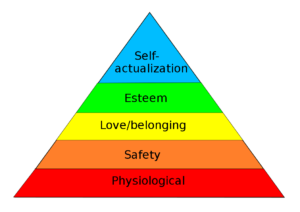I believe the operating definition of organizational behavior must start with a creative mission statement. I believe employers can help employees do outstanding things just by helping them achieve a mental picture of what they are able to accomplish. People want to excel and stand out among the rest. They want to be excellent employees in an excellent company. The problem arises when a top-performing company with top-quality employees, whom for some reason or another, lack that extra enthusiasm for their job and the tasks involved. The solution then becomes the methods used to create a common goal or vision which will help employees become prosperous and successful.
 The ideal scenario is to be able to provide a mission statement in which each employee would follow without hesitation. The mission statement must be equivalent in its definition, and how that definition is interpreted, by both the employer and the employee. Both the company and employee must be driven toward the same goals of success. By shining the light, you give your employees the idea of what a well-run company should look like.
The ideal scenario is to be able to provide a mission statement in which each employee would follow without hesitation. The mission statement must be equivalent in its definition, and how that definition is interpreted, by both the employer and the employee. Both the company and employee must be driven toward the same goals of success. By shining the light, you give your employees the idea of what a well-run company should look like.
One ideal method of creating this type of vision is to make the company’s mission statement attractive. Use emotion to capture the hearts of your people. There have statistically been more successful plans that originated out of emotion and liveliness than there have for plans which rely on logic and statistical data. The more attractive your plan appears, the more enthusiastically driven people will become. This will give them the energy to make sure the overall objectives are met and that success prevails.

Another well-defined method of creating a common vision of success would be to eliminate the unnecessary. Try not to include statements concerning leadership and profit, for example,phrases such as, “We are here primarily to make a profit for our stockholders” or “In order to be a leader you must…” These methods are outdated in today’s business world, and they lack a centralized commonly understood goal. Never be too verbose with your mission statement. Keep it clear, precise, and to the point. Your employees must be able to understand it and even relay it on to their peers. If an employee can not tell you what the mission statement is, then it is entirely useless. An employee must know it, believe in it and have the desire to fulfill its final objective.
A third area that needs consideration is the area of dealing with making the facts evidentially apparent. By saying that your company’s goal is to “make a profit” would be more than obvious to anyone in the business world of today. A good example would be, “We drink water so we can stay alive.” I think we all already know why we drink water. Even though drinking water will keep us alive, it is not the definition of why we are here.
 A successful mission statement providing a well thought-out vision, which connects with the emotions of your employees, will drive the entire company in the right direction. Employees do not want to be part of the fiscal results. Employees want to know they make a difference in someone’s life. They want to follow a goal that will help them feel good about themselves and the beliefs they represent.
A successful mission statement providing a well thought-out vision, which connects with the emotions of your employees, will drive the entire company in the right direction. Employees do not want to be part of the fiscal results. Employees want to know they make a difference in someone’s life. They want to follow a goal that will help them feel good about themselves and the beliefs they represent.
A company with an unclear mission statement will go nowhere. Your employees can be working their extremely hard,but if they are all working at different paces with different styles, then issues become petty and importance is thrown out the window. When the work is being done through physical motor activity rather than from the heart, this is when the true meaning of what is trying to be accomplished becomes useless.
Having the ability to create a company’s mission statement is not only the most difficult task to accomplish, but it can also be one of the most powerful tools available. I feel the mission statement defines the operating definition of organizational behavior. Organizational behavior is the ability to control the feelings, desires and drives of your employees towards a common goal of success.
Before understanding how to create a successful operational motivational plan, one must first come to terms with the definition of self-actualization. Only then will we be able to achieve the value-added results we plan on contributing to the organization.
Human Needs
 Dr. Abraham Maslow’s five levels of human needs are survival, security, social acceptance, self-esteem and self-actualization. Self-actualization is at the top of the hierarchical pyramid. This structure defines everything a person is capable of becoming.
Dr. Abraham Maslow’s five levels of human needs are survival, security, social acceptance, self-esteem and self-actualization. Self-actualization is at the top of the hierarchical pyramid. This structure defines everything a person is capable of becoming.
Reality
There are many characteristics which make up a self-actualizing person. One characteristic is that of realism. The trait of being realistically oriented with an efficient perception of reality and to also be comfortable with this behavior is very characteristic of a self-actualizing person. The ability to reason, think logically and see the truth are adherent qualities as well.
Self-Acceptance
Another characteristic is that of self-acceptance. Accepting yourself, the world and the others around you give you the ability to live without guilt, shame, regret and other unnecessary inhibitions.
Ethics
A self-actualizing person whose ethics are independent and unaffected by conventional methods is motivated toward continual growth. Naturalness and simplicity sprought spontaneity from within the self-actualized person.
Focusing
Another characteristic of a self-actualizing person is the ability to center or focus on problems. This focus generates outside of himself and requires much energy. Serenity and a worry free attitude, along with a devotion to duties, make the reasons for this person’s existence.
Detachment
A self-actualized person has the need for detachment and privacy. It is easy for this person to be alone and not lonely. This characteristic is defined as having the trait of owning up to one’s behavior and retaining dignity through times of great personal misfortune. This person is a self-motivator and is responsible for himself.
The self-actualized person is truly independent of culture and the environment. An appreciation of people and the basic goodness in life is observed. Living with this person is truly spiritual, motivating and uplifting as the moments of the here and now are enjoyed and experienced to the fullest.
Concerning peak experiences, Abraham Maslow said, “Feelings of limitless horizons opening up to the vision, the feeling of being simultaneously more powerful and also more helpless than one ever was before, the feeling of ecstasy and wonder and awe, the loss of placement in time and space with, finally, the conviction that something extremely important and valuable had happened so that the subject was to some extent transformed and strengthened even in his daily life by such experiences.”
A very vivid characteristic of a self-actualized person is that of interpersonal relationships. Viewing the sympathy, kindness and affection for mankind makes it clear that this person is capable of great love and shares his affection and friendliness with everyone.
The self actualized person will never discriminate and through humble portrayals, will learn from anyone regardless of class, education, race, color or political belief.
A self-actualized person has great creativity. He is original and uninhibited in his approach. This makes him inventive with an individualistic uniqueness.
Imperfections
Another characteristic of a self-actualized person is the ability to be painfully aware of his own imperfections and at the same time, have an awareness of his own growth process.
The self-actualized person is realistically human because of the sociological methods in which he accepts himself, mankind, physical reality and the social world around him.
The Plan
There are eight important topics which need to be addressed when writing an operational motivational plan. In a written plan, my first two topics are not the key focus of the plan, but only an organizational tool used to help lay out an organized look and feel.
Cover Page
The first section is the cover page. The name of the company, its phone number, and the chief executive’s name will reside within. That may seem obvious but you would be amazed how many business plans turn up without the proper heading. Imagine the frustration of reading a great business plan and then to not have the phone number directly in front of you so that you can call and congratulate this person on a plan well written. Also, a good idea would be to number the plans in the case of multiple business plans. This will allow you the ability to track plans. A nondisclosure statement will be necessary to protect the ideas and rights associated with the plan.
Table Of Contents
The second section will consist of the table of contents. The table of contents will allow a logical arrangement of all sections contained within the business plan. All pages will be numbered. It is surprising to see the number of business plans which contain no page numbers. As minuscule a matter as it seems, page numbers add organization and help navigate through the report during presentations.
Executive Summary
The executive summary is the heart of the operational motivational plan. Under the strict supervision of trusted managerial coworkers, the idea of management by objective will be utilized. Management by objective (MBO) is the means of motivating people versus controlling them. The goal is to convert organizational objectives into specific objectives. The main directives containing the drive for MBO are the employee recognition style and the employee involvement style.
Employee Recognition
The employee recognition program is the act of delivering recognition to both groups and individuals with the anticipated result of creating motivation and repetition of successful accomplishments. The “employee of the month” program is a good recognition style. Along with being recognized as the employee of the month, the employee will also be moderately rewarded with movie passes, shirts, or a small reward. Groups will be recognized the same way.
Employee Involvement
Employee involvement will be designed to create an enhanced commitment to the organization. The method will be to provide the employee with a significant amount of decision-making involvement with their management. Another aspect of employee involvement will be to let the worker participate in decision-making through small groups, which will represent the employees in that group.
The Mission Statement
Since this operational motivational plan is in writing, it will consist of basic information about the company. This will provide all the information necessary for providing an insight into the product concept and the evolution of the market. This section of the plan will consist of the company’s current status, the company’s future strategy and the action required achieving the company’s goals. These actions are referred to previously in the executive summary section. In summary, the mission statement will provide information concerning the company’s past, present and future.
Management
The role of management will be to identify the market. Identifying the market is defined as assessing targeted customer groups, the competition and marketing efforts. Included is the analyzation of how fast the market is growing and to what scale will the company’s product be demanded.
Sales & Promotion
Management will also assess how customers will be reached and how the marketing plan will be carried out. Management will make all the decisions on how to sell to customers. Decisions concerning public relations and sales techniques will also be determined by management.
The Team
The major role of the organization is to become familiar with the concepts which strive towards a self-actualized person whom understands the fundamental principles of teamwork. Teamwork will be taught and stressed in all facets of the business.
Value-Added Results
The value-added results, which will add to the organization, will come from the mastering of becoming a self-actualized person along with being able to motivate within the company’s mission statement. The value will be noted in the signs of motivation and cooperation amongst coworkers.
Conclusion
It is always difficult to analyze a vast number of motivational theories and determine which methods will best achieve positive results for the company. The methods described within this plan encompass a basic path of success. Through proper implementation, the value-added results will be seen.
This is a literature review relevant to leadership qualities and the methods implemented to achieve results in today’s complex organizations.
Methods to identify appropriate problems in an organization
Establish internal controls
An effective control environment is essential in helping to identify problems in an organization. Rules must exist and deviations from these rules must be dealt with immediately. For small businesses, investments in expensive systems is not necessary. Control can be as simple as having one person handling the accounting activities versus two people.
 If a business is losing money internally, a set of internal controls would help safeguard the financial assets such as cash and accounts receivables. Internal controls are as simple as a requirement that certain duties be performed by specific people each day such as posting accounts or opening the mail.
If a business is losing money internally, a set of internal controls would help safeguard the financial assets such as cash and accounts receivables. Internal controls are as simple as a requirement that certain duties be performed by specific people each day such as posting accounts or opening the mail.
Fraud is a problem in business that can be controlled through internal controls. Steps taken to create awareness that controls are in place to detect such activities will yield dividends. Making employees take vacations would require cross training of duties and would make it difficult for an individual to conceal a fraudulent activity over an extended period of time.
Get involved with daily operations
It pays to get out into the company and view the operations. Whether the company is 10 employees or 100 employees in a manufacturing environment, if the employees see you enough they may be more willing to talk with you. You may even observe inefficient processes taking place in operations.
Businesses experience incidents of employees taking home food from the restaurant at the end of the night or serving extra drinks for free in order to get larger tips. In the case of the bartender, an inventory process can be established where inventory is taken at the beginning and end of shifts and could be checked against the detailed sales transactions of a point-of-service system.
Another effective method of identifying business problems in the operational process can be to start a suggestion box. Give rewards to employees who identify solutions to operational problems or cost saving ideas.
Create accountability
Create involvement in everyday operational procedures. Have department managers submit summary reports outlining budgets and forecasting. Hold these managers accountable for their forecasts. Compare these numbers with actual numbers and identify variances known as operational problems.

Budget variance reports can be distributed to each manager listing variances and a quick meeting can be held. The practice of holding these meetings helps hold managers accountable and informs everyone as to why operational costs were higher or lower than expected compared to the formal budget.
Absolute accountability helps identify mistakes when they occur. For example, a company that reviews its electric bill and realizes that they paid twice as much this month than last month. After further review it was identified that the electric bill was posted twice by mistake. This discovery resulted in a change in the process which prevented this from happening again. If expense reports are not reviewed on an ongoing basis this could result in a permanent loss to the organization.
Reasons for the failure of organizational initiatives
Several reasons for the failure of organizational initiatives include poor communication, poor change management, lack of leadership, poor project management, poor planning, and a lack of sound business practice.
Poor communication
 Corporations require communication. Companies both large and small depend on communication whole heartedly. Communication can be achieved through email, blogs, group meetings, wikis, bulletin boards, and any other method you can think of that will help create communication. Communication can be handled by an employee as a full time position.
Corporations require communication. Companies both large and small depend on communication whole heartedly. Communication can be achieved through email, blogs, group meetings, wikis, bulletin boards, and any other method you can think of that will help create communication. Communication can be handled by an employee as a full time position.
Poor change management
Resistance to change can cause problem in organizations. People want to know how their involvement involves them and how they can benefit from their involvement. A leader that will help catapult the initiatives and constantly promote the initiatives will help promote the vision. People feed on positive energy.
Lack of leadership
A leader must show excellence in the key areas of technology, business, and people. If one of these things is missing then failure is imminent. A leader must exemplify devotion and hard work. A leader cannot assign loads of work to his or her team and then leave early for the weekend. This will cause much discontent among the team members. People skills are also a must for a leader. Without people skills, projects cannot succeed. The needs of the team must always be kept into consideration.
Poor project management
Managing scope and requirements is key to any project. Logistics need to be identified and managed properly. Tasks can span across several teams and across several departments. Communication across these levels to all people is necessary for success. Risk management also plays a role in project management.
Poor planning
Initiatives require well thought out strategy. Unrealistic expectations and rushing into projects head first without any idea of how goals will be accomplished is a recipe for failure. Teams must take the time to put a road map together from beginning to end. This will ensure that the initiatives are given the proper chance for success.
Lack of sound business case
SOA (Service Oriented Architecture) projects can make perfect sense but if they do not carry any business context then they are a waste of time. Initiatives must be justified with business drivers. Merely having lots of documents and a nice service oriented architecture does not convince businesses to use the plan.
Why solutions fail during implementation and do not yield sustainable results
Several reasons why solutions fail during implementation and do not yield sustainable results include a lack of strong executive sponsorship, trying to do things cheaply, and lack of technical knowledge.
Lack of strong executive sponsorship
There needs to be someone in place that carries a little clout. Someone that can help clear hurdles and remove obstacles so that work can be completed. This is an important factor in change management.
Trying to do it cheap
Businesses want everything for nothing. They want all the bells and whistles but are unwilling to invest the time and money it takes to get those bells and whistles. Projects that use this strategy will run over budget, are late, are missing many features, and have many quirks and glitches due to the approach taken. Doing things quick and dirty will create gaps in resources that can cause an entire project to fail. Shortcomings such as lack of documentation, and not enough bandwidth to test all case scenarios are two examples of doing things quick and dirty. These resources are needed eventually and the lack of them during the process causes stress and aggravation among team members. This quick and dirty approach always ends up costing more in the long run. Not providing the proper time to architect the process out completely can cause burn out among team members.
Lack of technical knowledge
Enterprise Architecture initiatives require a comprehensive understanding of architecture, application development, infrastructure, process, security, and the business. All the leadership and communication in the world cannot make up for a lack of technical know-how. If you do not have this person or persons then the initiative is dead in the water.
Suggestions for improving performance
Three successful initiatives for improving performance in American organizations have emerged from successful performance excellence initiatives. First, TQM was a strategic management approach (Wruck & Jensen, 1998) that required strong management support for quality improvement and leadership commitment to a cultural change (Beer, 2003). Second, leaders got employees emotionally connected to the organizational mission and involved in quality efforts (Trahant & Burke, 1997). Third, successful performance excellence initiatives required a strong customer orientation where satisfying customers was a priority for everyone (Beer, 2003; Zemke & Schaaf, 1989).